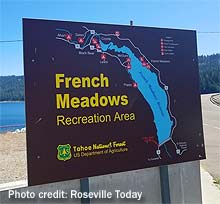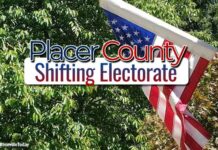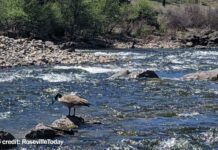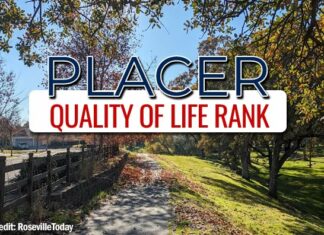Partnership Doubles Pace in Second Season of Work
FRENCH MEADOWS, Calif. – After six months of strategic forest treatments, partners of the French Meadows Forest Restoration Project (Project) are wrapping up their second season of implementation work.
Located in the headwaters of the Middle Fork American River, in the Tahoe National Forest, the Project aims to restore forest health by reducing high-severity fires across 28,000 acres of critical watershed, and to study the effects of forest treatments on ecosystem health. In its second season, the partnership expanded its efforts beyond the heavily-trafficked area around French Meadows Reservoir and into the upper reaches of the watershed.
Most destructive fire season on record
“This year was California’s most destructive fire season on record, and the partnership had particular interest in providing immediate safeguards against catastrophic wildfire in remote areas where California spotted owls are known to inhabit,” explained Brett Storey, project manager with Placer County, which coordinates the stewardship agreement with the Tahoe National Forest.
Because of the remoteness and sensitivity of the treatment area, crews primarily employed hand-thinning methods, as opposed to more mechanical methods. Despite more time-consuming treatment methods, the partnership treated more than 2,100 acres of public land, which is double the pace from last year. The cumulative acreage of federal land treated over two seasons now stands at more than 3,100 acres. On adjacent private land, the American River Conservancy has independently raised funds and treated 1,100 acres, as a collaborative aspect of this all-lands approach to watershed management.

Lumber and renewable energy
In 2020, the partnership brought in more than 1.4 million board feet to a local mill, and more than 1,200 tons of biomass to local renewable energy facilities to help offset restoration costs. Partners also prepped 50 acres of a burn scar, from a previous wildfire, for reforestation next season and repaired approximately 16 miles of road. The work this year employed more than 100 local contractors.
“The French Meadows Forest Restoration Project continues to demonstrate how a diverse partnership with a shared interest can produce tangible results for our forest ecosystems and surrounding communities,” said Placer County Water Agency General Manager Andy Fecko. “There is more work to be done, but we are very pleased with the progress so far.”
Prescribed fires and change management
In coming years, the Project will implement two significant programs to complement the forest treatments currently underway. First will be the introduction of prescribed fires. Extremely dry forest conditions precluded safe burns this season and last, but the United States Forest Service and The Nature Conservancy, the two entities managing the prescribed fire component of the Project, have cleared six miles of control line in preparation for prescribed burns on 600 acres of forestland.
The second program will be comprised of research conducted by the Sierra Nevada Research Institute at the University of California, Merced to assess how changes in vegetation affect changes in the water balance of the ecosystem; most of that monitoring equipment has now been installed.
Catalyst for action
The catalyst of the French Meadows Forest Restoration Project was the 2014 King Fire, which burned over 97,000 acres in the American River watershed, much of it at high intensity. Eager to reduce the risk to hydroelectric assets, water quality, and biodiversity from future fires, Placer County Water Agency (PCWA) joined with Placer County, The Nature Conservancy (TNC), the United States Forest Service (USFS), American River Conservancy (ARC), Sierra Nevada Conservancy (SNC), and the Sierra Nevada Research Institute (SNRI) at the University of California, Merced, to form the French Meadows Partnership. The Project spans more than 22,000 acres of federal land, nearly 7,000 acres of private land, and is a test case for the partnership’s effectiveness in improving fire resilience and the overall health of the watershed. Partners of the Project hope to not only moderate future wildfire behavior, but also create a new model for advancing forest and watershed restoration.
(21+ years strong)
Welcome to the brighter side!
Get in front of local customers! 24/7 (365)




















